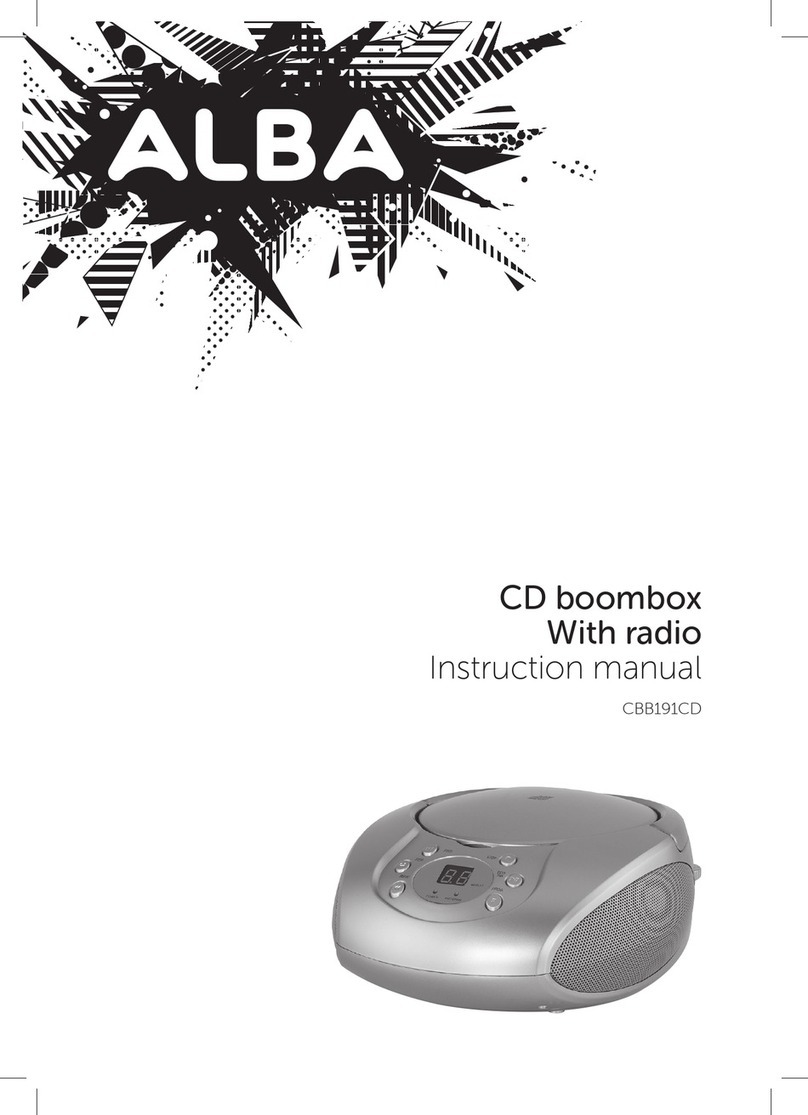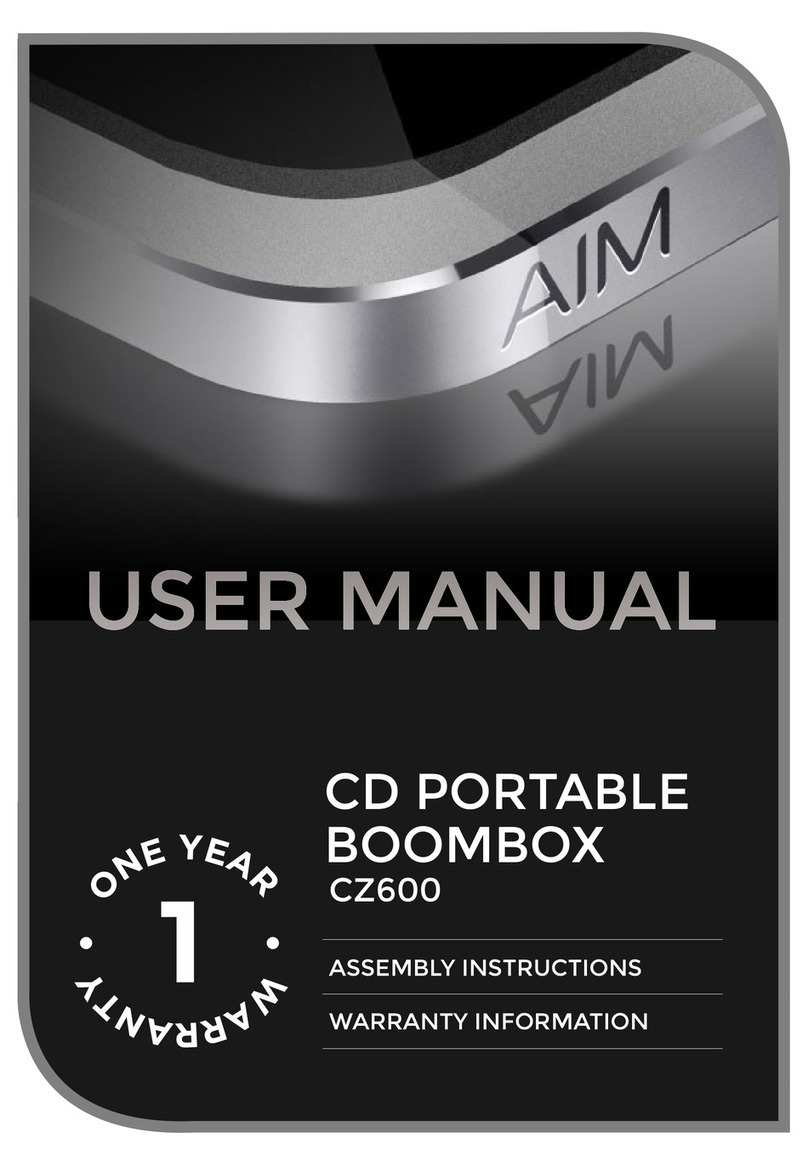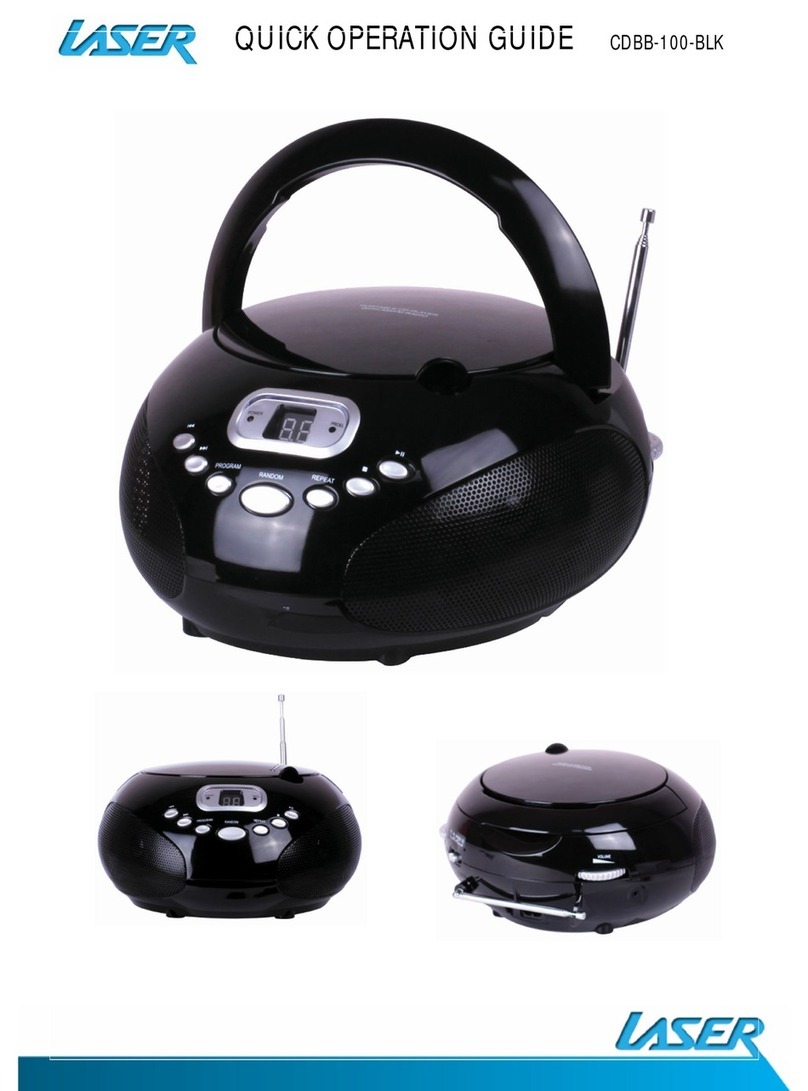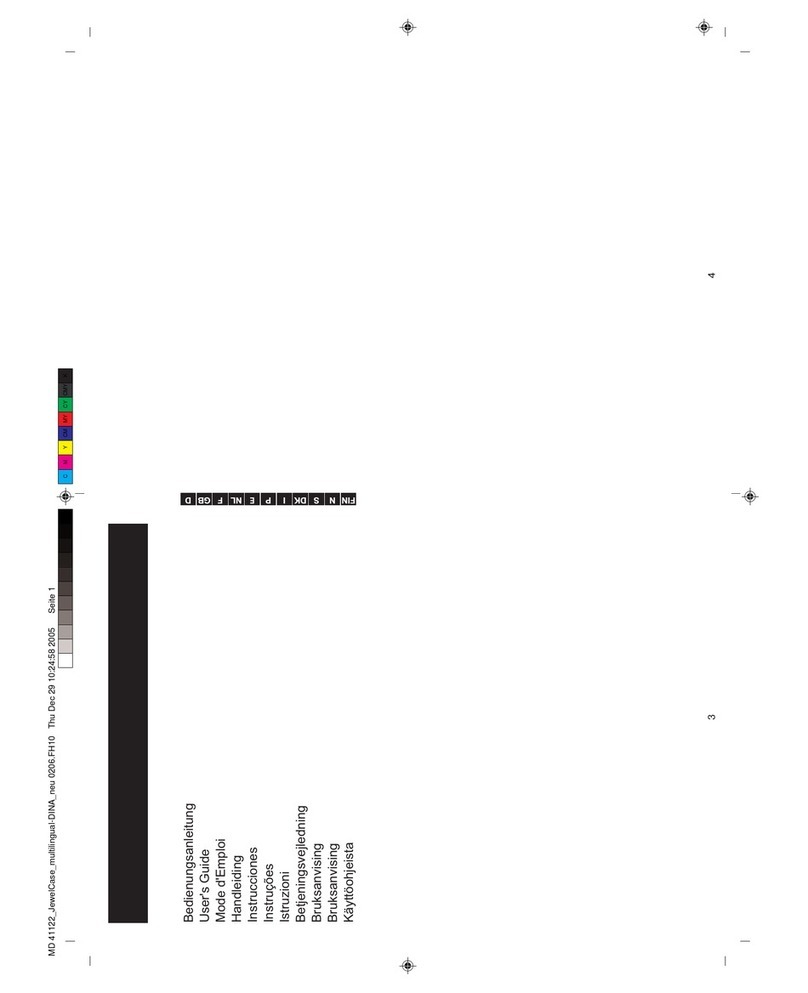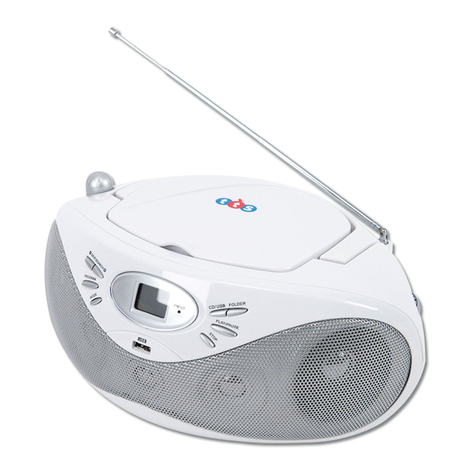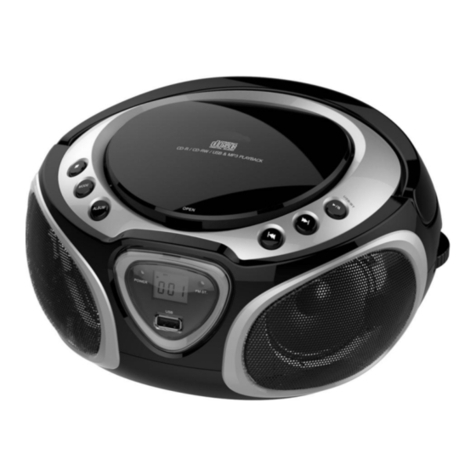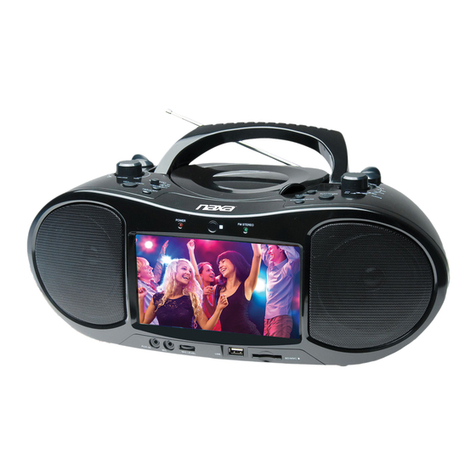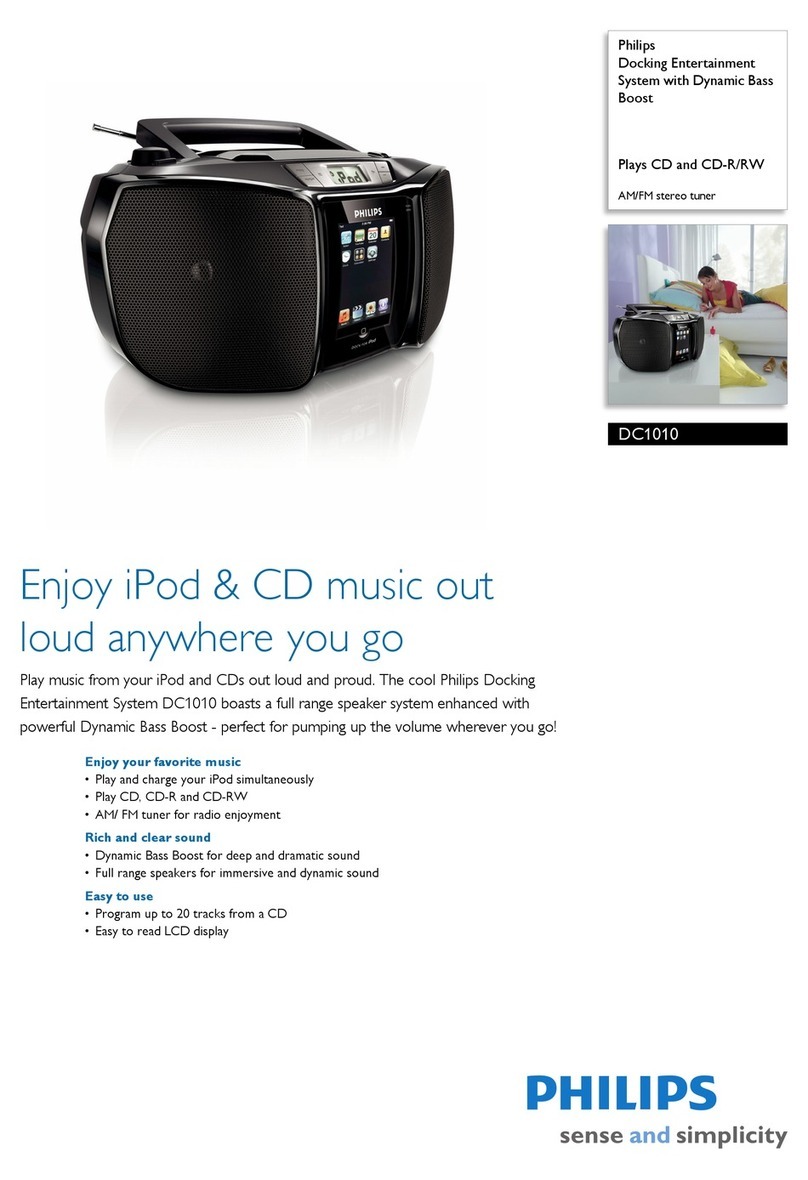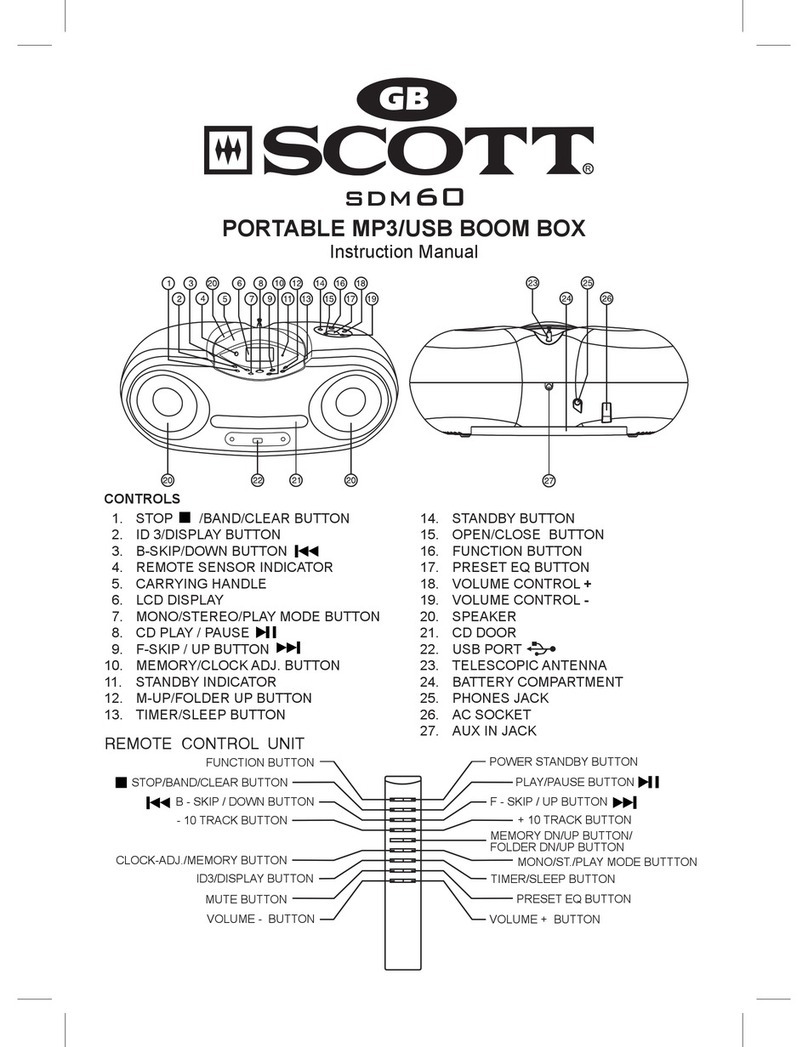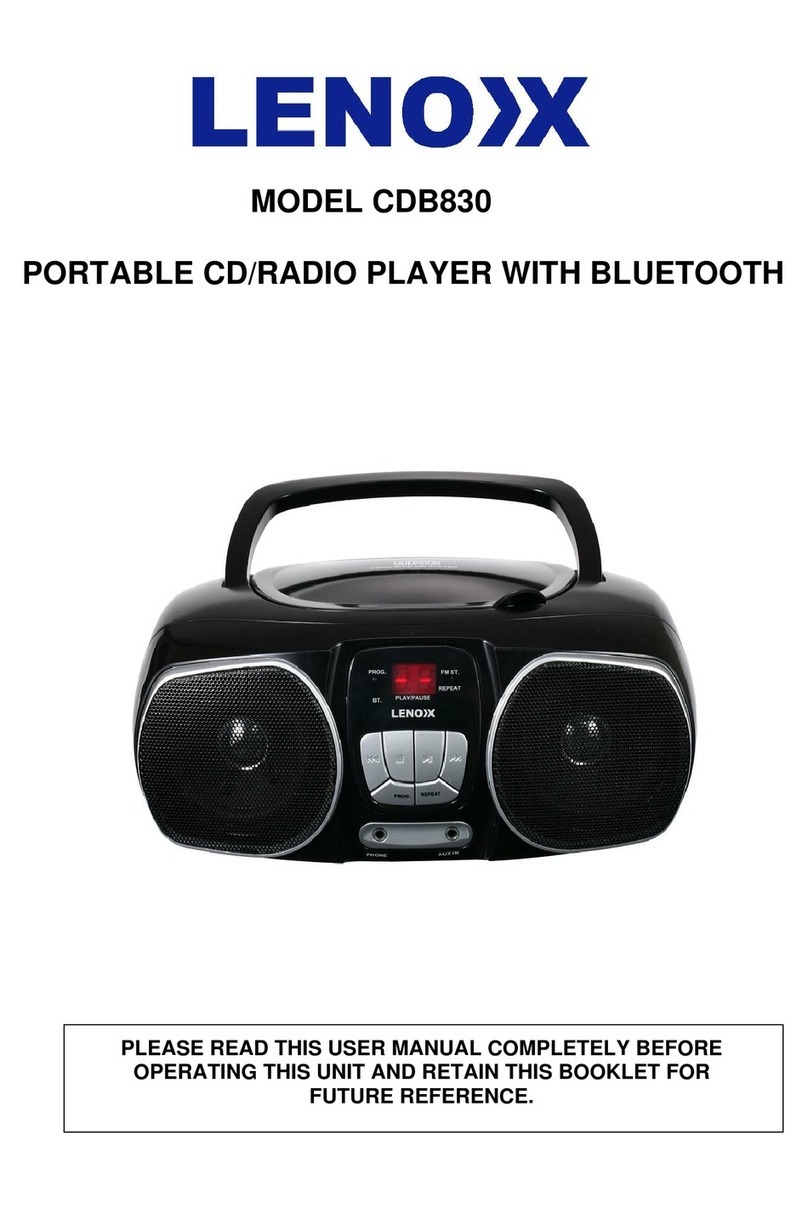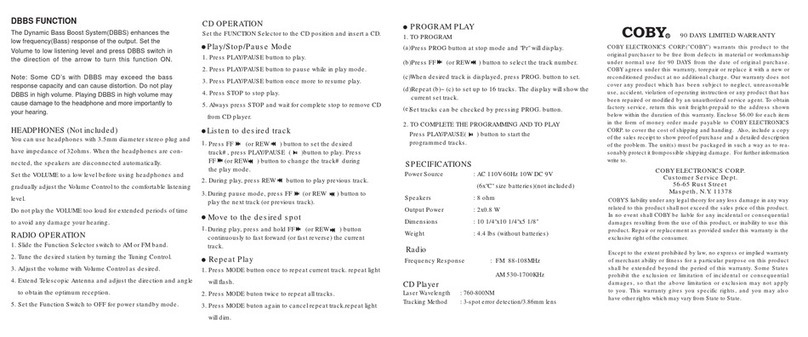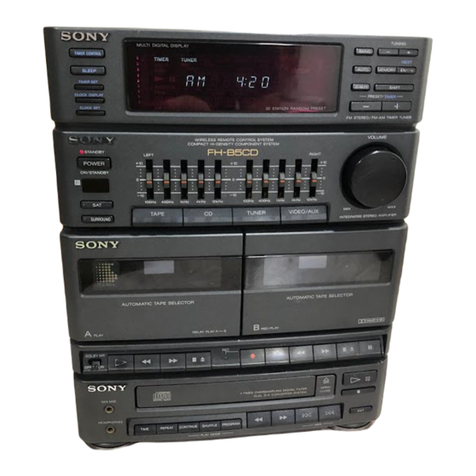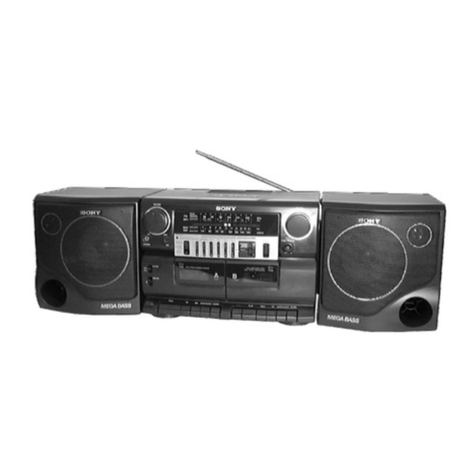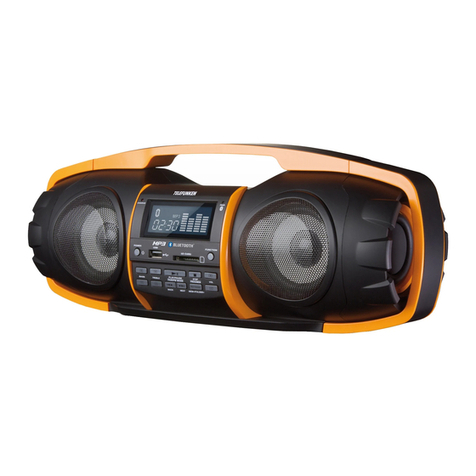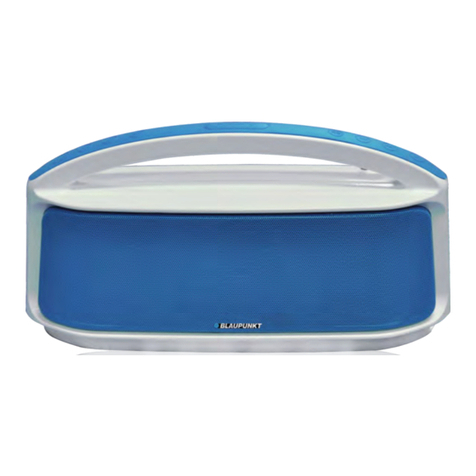Daewoo DBU-51 User manual

DBU-51
MANUAL DE INSTRUCCIONES
REPRODUCTOR CD/MP3/USB PORTÁTIL
CON RADIO ESTÉREO

ES
2
PRECAUCIÓN
RIESGO DE DESCARGA
ELÉCTRICA. NO ABRIR.
El símbolo de un rayo
acabado en echa dentro
de un triángulo equilátero
advierte al usuario de
la presencia de voltaje
peligroso sin aislar dentro
de la caja del producto y
que puede ser de magnitud
suciente como para
constituir riesgo de descarga
eléctrica para las personas.
El signo de exclamación
dentro de un triángulo
equilátero avisa al usuario
de que, por motivos de
seguridad, un componente
determinado solo puede
ser reemplazado por el
componente especicado en
la documentación.
ADVERTENCIA: PARA REDUCIR EL
RIESGO DE DESCARGA ELÉCTRICA,
NO ABRA LA CUBIERTA (O PARTE
POSTERIOR). EL INTERIOR NO
CONTIENE PIEZAS QUE DEBA
MANIPULAR EL USUARIO.
CONTACTE CON EL SERVICIO
TÉCNICO.
PRECAUCIÓN
Peligro de explosión si la batería se cambia incorrectamente.
Utilice solo baterías iguales o equivalentes.
1. ADVERTENCIA: Consulte la información eléctrica y de seguridad que encontrará en la
parte inferior de la carcasa antes de instalar o poner en funcionamiento el aparato.
2. ADVERTENCIA: Para reducir el riesgo de incendio o descarga eléctrica, no exponga el
aparato a la lluvia o humedad. El aparato no puede estar expuesto a goteos ni salpicaduras,
y no coloque objetos que contengan líquidos, como jarrones, encima del aparato.
3. ADVERTENCIA: La batería (batería o baterías o grupo de baterías) no debe estar expuesta
a temperaturas elevadas como luz solar directa, llamas vivas o similares.
4. ADVERTENCIA: La clavija de red se utiliza como dispositivo de desconexión, deberá poder
accionarse fácilmente.
5. Si se abre el aparato existe radiación láser invisible. Evite la exposición a la luz
láser.
6. Eliminación correcta de este producto. Esta marca indica que, en toda la UE, este
producto no debe eliminarse junto con otros residuos domésticos. Para evitar posibles
daños al medio ambiente o la salud humana debidos a eliminaciones no controladas de
residuos, recíclelo de manera responsable para fomentar la reutilización sostenible de
los recursos materiales. Si desea devolver su dispositivo ya utilizado, utilice los sistemas
de devolución y recogida, o contacte con el minorista donde adquirió el producto y se
encargará de eliminar el producto conforme a un reciclaje seguro para el medio ambiente.
7. No coloque encima del aparato fuentes de llama viva, por ejemplo, velas.
8. Preste atención a los aspectos medioambientales de la eliminación de baterías.
9. Utilice el aparato en climas moderados.
10. Las características eléctricas se encuentran en la parte inferior de la unidad.
11. Una presión sonora excesiva en auriculares y cascos puede causar pérdida de audición.
12. Debe poder acceder con facilidad al enchufe de la unidad.
13. Para desconectar por completo la entrada de corriente, el enchufe del aparato debe
estar desconectado de la red eléctrica.
ADVERTENCIA
PARA EVITAR EL RIESGO DE INCENDIO O DESCARGA ELÉCTRICA, NO EXPONGA ESTE
APARATO A LA LLUVIA O HUMEDAD.

ES
3
La unidad incluye la siguiente etiqueta que informa acerca del procedimiento correcto para
trabajar con luz láser:
ETIQUETA DE PRODUCTO LÁSER DE CLASE 1
Esta etiqueta se adjunta para informar que el aparato
contiene un componente láser.
ETIQUETA DE ADVERTENCIA SOBRE RADIACIÓN
Esta etiqueta se encuentra dentro de la unidad, como se
muestra en la imagen, para advertir acerca de medidas
adicionales. El equipo contiene rayos láser cuya radiación
es conforme al límite establecido para productos láser de
clase 1.
INSTRUCCIONES DE SEGURIDAD
1. LEA LAS INSTRUCCIONES. Lea todas las instrucciones de seguridad y funcionamiento antes
de poner en funcionamiento el aparato.
2. CONSERVE LAS INSTRUCCIONES. Conserve las instrucciones de seguridad y mantenimiento
para futuras consultas.
3. PRESTE ATENCIÓN A LAS ADVERTENCIAS. Respete todas las advertencias incluidas en la
unidad y en las instrucciones de funcionamiento.
4. SIGA LAS INSTRUCCIONES. Siga todas las instrucciones de funcionamiento.
5. AGUA Y HUMEDAD. El aparato no se debería utilizar cerca de agua, por ejemplo, cerca de
una bañera, lavabo, fregadero de la cocina, lavadero, piscina o en sótanos húmedos.
6. VENTILACIÓN. El aparato debería situarse de forma que su posición no impida una correcta
ventilación. No lo que coloque sobre una cama, sofá, alfombra o supercie similar que pueda
bloquear los oricios de ventilación, ni en lugares empotrados como librerías o armarios que
impidan la circulación del aire a través de los oricios de ventilación.
7. CALOR. Instale el aparato lejos de fuentes de calor como radiadores, estufas u otros
electrodomésticos (incluidos amplicadores) que generen calor.
8. FUENTE DE ALIMENTACIÓN. Conecte el aparato solo a una fuente de alimentación del tipo
descrito en las instrucciones de funcionamiento o indicado en el aparato.
9. PROTECCIÓN DEL CABLE ELÉCTRICO. Los cables eléctricos deberían tenderse por zonas
donde no puedan ser pisados ni puedan colocarse otros objetos sobre los cables.
10. LÍNEAS ELÉCTRICAS. La antena exterior debería situarse lejos de las líneas eléctricas.
11. ENTRADA DE OBJETOS y LÍQUIDOS. Vaya con cuidado para que no caigan objetos ni se
viertan líquidos sobre el aparato.
12. DESCARGAS ELECTROESTÁTICAS. Si la pantalla no funciona correctamente o el aparato no
responde a ninguno de los controles, quizás se deba a una descarga electroestática. Apague
y desconecte el aparato, y vuelva a conectarlo tras unos pocos segundos.

ES
4
Inserte 6 baterías
tipo“C” en el
compartimento
A entrada de CA A toma mural
13. DAÑOS QUE REQUIEREN REPARACIÓN. El aparato debe ser reparado por personal
técnico cualicado cuando:
a. El cable eléctrico o el enchufe han resultado dañados.
b. Han caído objetos o se ha vertido líquido sobre la carcasa del aparato.
c. El aparato ha estado expuesto a la lluvia.
d. El aparato se ha caído o la carcasa está dañada.
e. El aparato no funciona con normalidad.
14. REPARACIONES Y MANTENIMIENTO. El usuario no debería intentar reparar el aparato
más allá de lo descrito en las instrucciones de funcionamiento dirigidas al usuario. El resto
de tareas de reparación y mantenimiento debe llevarlas a cabo personal técnico cualicado.
Notas:
a. Un disco compacto (CD) sucio o rayado puede saltar. Limpie o cambie el CD.
b. Si se produce un error o mal funcionamiento, desconecte el cable de CA y extraiga todas
las baterías. Luego vuelva a encender la unidad.
ANTES DE PONER EN FUNCIONAMIENTO EL APARATO
Notas: SOBRE LOS CD.
Dado que los discos sucios, dañados o combados pueden estropear el aparato, vaya con
cuidado con los elementos siguientes:
a. CD utilizables. Utilice solo CD que contengan la marca
que se muestra a continuación.
b. CD solo con señales de audio digital.
FUENTES DE ALIMENTACIÓN
ALIMENTACIÓN POR CORRIENTE ALTERNA (CA)
Puede alimentar el sistema conectando el cable de CA a la entrada de CA que encontrará en
la parte posterior de la unidad y a una toma mural de CA. Compruebe que la tensión nominal
de su aparato se corresponda con la tensión local. Asegúrese de que el cable de CA esté bien
insertado en el aparato.

ES
5
ANTENA FM
SELECTOR DE
FUNCIONES
CONTROL
DE
VOLUMEN
RANURA
USB
PANTALLA LCD
SALTAR+
SALTAR -
MODO
REPRODUCCIR/PAUSA
STOP
ALBUM
INDICADOR FM ESTÉREOINDICADOR DE ENCENDIDO
SINTONIZADOR
PUERTA
SELECTOR DE
FRECUENCIA
ABRIR/CERRAR
INDICADOR
DE DIAL
BOTONES PARA CINTAS - PAUSA, STOP/EXPULSAR, AVANZAR, RETROCEDER, REPRODUCIR, GRABAR
PUERTA CASSETTE
ALIMENTACIÓN POR BATERÍAS
Introduzca 6 baterías de tipo “C” en el compartimento de las baterías. Compruebe que las
baterías estén bien insertadas para evitar daños en el aparato. Extraiga siempre las baterías si
prevé que no utilizará el aparato durante un largo período de tiempo, ya que de lo contrario
las baterías podrían tener fugas y dañar el aparato.
Notas:
- Utilice baterías del mismo tipo. Nunca mezcle baterías de diferentes tipos.
- Para utilizar el aparato con las baterías, desconecte el cable de CA.
LOCALIZACIÓN DE LOS CONTROLES

ES
6
Reoriente la antena para
mejorar la recepción. Reoriente el aparato para
mejorar la recepción AM.
FUNCIONAMIENTO DE LA RADIO
FUNCIONAMIENTO GENERAL
1. Ajuste el selector de funciones en modo“RADIO”.
2. Utilice el selector“BAND”para seleccionar la frecuencia que desee.
3. Ajuste la frecuencia de radio en la emisora que preera utilizando el sintonizador.
4. Ajuste el volumen en el nivel deseado.
RECEPCIÓN FM/FM ESTÉREO
- Ajuste el selector“BAND”en modo FM para recepción MONO.
- Ajuste el selector“BAND”en modo FM ST. Para recepción FM ESTÉREO. El indicador
luminoso de estéreo mostrará el modo FM ST.
PARA MEJORAR LA RECEPCIÓN
FUNCIONAMIENTO DEL CASSETTE
FUNCIONAMIENTO GENERAL
PAUSA
II
II Pulse este botón para detener temporalmente la reproducción de la cinta.
Vuelva a pulsarlo para reanudar la reproducción.
STOP/EXPULSAR Pulse para detener el funcionamiento de la cinta.
Vuelva a pulsar para abrir la puerta del cassette cuando la cinta
haya dejado de girar.
AVANZAR& Pulse para mover rápidamente la cinta hacia delante o hacia atrás.
RETROCEDER
REPRODUCIR Pulse para iniciar la reproducción de la cinta.
GRABAR Pulse junto con el botón de REPRODUCIR para empezar a grabar.
REPRODUCIR
1. Ajuste el selector de funciones en modo“TAPE”.
2. Pulse el botón de STOP/EXPULSAR para abrir la puerta del cassette e introduzca la cinta.
3. Cierre la puerta del cassette.
4. Pulse el botón de REPRODUCIR para iniciar la reproducción de la cinta.
5. Ajuste el volumen al nivel deseado.
6. P
ulse el botón de PAUSA cuando quiera detener temporalmente la reproducción de la cinta.
7. Pulse el botón de STOP/EXPULSAR cuando desee nalizar la reproducción.

ES
7
GRABAR
1. Pulse el botón de STOP/EXPULSAR para abrir la puerta del cassette e introduzca una cinta virgen.
2. Seleccione la fuente que desea grabar.
Para grabar de la radio: Ajuste el selector de funciones en modo“RADIO”y ajuste la
emisora deseada.
Para grabar de CD/MP3 : Coloque un CD en el compartimento. Ajuste el selector de
funciones en modo“CD/MP3/USB” y seleccione la pista que desee.
Para grabar de USB: Conecte o introduzca un dispositivo USB. (Compruebe que no
haya ningún disco en la bandeja para discos). Ajuste el selector de funciones en
modo“CD/MP3/USB” y seleccione la pista que desee.
3. Pulse el botón de GRABAR junto con el de REPRODUCIR para iniciar la grabación.
4. Pulse el botón de STOP/EXPULSAR cuando haya terminado.
FUNCIONAMIENTO DEL CD/MP3
FUNCIONAMIENTO GENERAL
PLAY / PAUSE
II
II Pulse para empezar a reproducir un disco CD/MP3. Vuelva a pulsar para
detener temporalmente la reproducción del CD/MP3. Y vuelva a pulsa
para reanudar la reproducción.
SALTAR +
I
I & Pulse para pasar a la pista siguiente o anterior.
SALTAR -
I
Pulse y mantenga pulsado durante la reproducción hasta que encuentre
el punto de sonido.
STOP Pulse para detener el funcionamiento del CD/MP3.
REPRODUCIR
1. Ajuste el selector de funciones en modo“CD/MP3/USB”.
2. Abra la puerta del CD e introduzca en el compartimento un disco CD/MP3 con la etiqueta
hacia arriba.
3. Cierre la puerta del CD.
4. Cuando el disco está dentro, se realiza una búsqueda. El número total de pistas aparece
en la pantalla.
5. La reproducción se iniciará automáticamente a partir de la primera pista.
6. Ajuste el volumen al nivel deseado.
7. Vuelva a pulsar el botón de REPRODUCIR/PAUSA si quiere detener temporalmente la
reproducción.
8. Pulse el botón de STOP cuando haya terminado.
FUNCIONAMIENTO DEL CD/MP3
FUNCIONAMIENTO GENERAL
El sistema permite programar hasta 20 pistas para discos CD y 99 pistas para discos MP3 y
reproducirlas en cualquier orden. No olvide pulsar el botón de STOP antes del uso
1. Pulse el botón “MODE”, en la pantalla parpadeará “P01”.
2. Seleccione la pista deseada utilizando los botones SALTAR + o SALTAR -. (Puede seleccionar
un álbum pulsando el botón“ALBUM”).
3. Vuelva a pulsar el botón“MODE” para conrmar la pista en la memoria del programa.
4. Repita los pasos 2 y 3 para introducir más pistas en la memoria del programa.
5. Una vez programadas todas las pistas que desee, pulse el botón de REPRODUCIR/PAUSA
para reproducir el disco en el orden programado.
6. Pulse dos veces el botón de STOP para poner n a la reproducción programada.

ES
8
REP REP
ALBUM REP
ALL
RAND
REPETIR 1
REPRO-
DUCCIÓN
ALEATORIA
REPETIR
TODO
REPRO-
DUCCIÓN
NORMAL
REPETIR
ALBUM
MODO
Pulse el botón “MODE” antes o durante la reproducción de un disco CD/MP3, con cada
pulsación el modo cambia de la siguiente forma:
1 - REPETIR 1
2 - REPETIR ÁLBUM (* SOLO MP3)
3 - REPETIR TODO
4 - ALEATORIO
5 - REPRODUCCIÓN NORMAL
FUNCIONAMIENTO DEL USB
FUNCIONAMIENTO GENERAL
REPRODUCIR/PAUSA
II
II Pulse para iniciar la reproducción de pistas desde el USB.
Pulse de nuevo para detener temporalmente la reproducción del
USB.
Vuelva a pulsar para reanudar la reproducción.
SALTAR +
I
I & Pulse para pasar a la pista siguiente o anterior.
SALTAR -
I
Pulse y mantenga pulsado durante la reproducción hasta que
encuentre el punto deseado de sonido.
STOP Pulse para nalizar el funcionamiento del USB.
REPRODUCIR
1. Conecte o inserte un dispositivo USB en el puerto.
2. Ajuste el selector de funciones en modo“CD/MP3/USB”.
3.
Si no hay ningún disco en la bandeja, la unidad leerá y reproducirá automáticamente el
USB.
4. Si hay un disco en la bandeja, leerá y reproducirá automáticamente el DISCO.
5. Pulse y mantenga pulsado durante unos pocos segundos el botón de REPRODUCIR/PAUSA
para acceder al modo USB.
6. La reproducción se iniciará automáticamente a partir de la primera pista.
7. Pulse el botón de STOP cuando haya terminado.
PROGRAMA MODO
El funcionamiento de PROGRAMA, MODO es el mismo que el de CD/MP3. Consulte el
apartado de FUNCIONAMIENTO DEL CD/MP3.
OTRAS FUNCIONES
APAGADO AUTOMÁTICO
Este producto incluye una función automática de ahorro de energía en el modo CD/MP3/
USB. Si la unidad se mantiene en STOP, PAUSA o sin disco durante más de 10 minutos,
automáticamente se apagará. Ajuste el selector de funciones en modo apagado y vuelva a
colocarlo en modo“CD/MP3/USB”o “Radio” si desea volver a encender la unidad.

ES
9
DECLARACIÓN DE CONFORMIDAD
Por medio de la presente Flamagas SA declara que el producto DBU-51 cumple los requisitos
y objetivos de protección básicos de:
• La Directiva 2006/95/EC de Baja Tensión
• La Directiva 2004/108/EC de Compatibilidad Electromagnética
Para obtener una copia completa de la declaración de conformidad visite la dirección:
www.electronicaamagas.com

DBU-51
USER MANUAL
USB/MP3/CD/CASSETTE/RADIO
PORTABLE PLAYER

ENG
CAUTION
RISK OF ELECTRIC SHOCK
DO NOT OPEN
The lightning ash with
arrowhead symbol within
an equilateral triangle, is
intended to alert the user to
the presence of uninsulated
dangerous voltage within
the products enclosure
that may be of sucient
magnitude to constitute
a risk of electric shock to
persons.
The exclamation point within
an equilateral triangle,
is used to indicate that a
specic component shall
be replaced only by the
component specied in that
documentation for safety
reason.
WARNING: TO REDUCE THE RISK
OF ELECTRIC SHOCK, DO NOT
REMOVE COVER (OR BACK), NO
USER SERVICEABLE PARTS INSIDE,
REFER SERVICING TO QUALIFIED
SERVICE PERSONNEL.
CAUTION
Danger of explosion if battery is incorrectly replaced.
Replace only with the same or equivalent type
11
1. WARNING: Please refer the information on exterior bottom enclosure for electrical and
safety information before installing or operating the apparatus.
2. WARNING:To reduce the risk of re or electric shock, do not expose this apparatus to
rain or moisture. The apparatus shall not be exposed to dripping or splashing and that no
objects lled with liquids, such as vases, shall be placed on apparatus.
3. WARNING: The battery (battery or batteries or battery pack) shall not be exposed to
excessive heat such as sunshine, re or the like.
4. WARNING: The mains plug is used as disconnect device, the disconnect device shall
remain readily operable.
5. Invisible laser radiation when open and interlocks defeated. Avoid exposure to
beam of laser.
6. Correct Disposal of this product. This marking indicates that this product should
not be disposed with other household wastes throughout the EU. To prevent possible
harm to the environment or human health from uncontrolled waste disposal, recycle it
responsibly to promote the sustainable reuse of material resources. To return your used
device, please use the return and collection systems or contact the retailer where the
product was purchased. They can take this product for environmental safe recycling.
7. No naked ame sources, such as lighted candles, should be placed on the apparatus.
8. Attention should be drawn to environmental aspects of battery disposal.
9. Use of the apparatus in moderate climates.
10. The rating and marking information are located at the bottom of the unit.
11. Excessive sound pressure from earphone and headphones can cause hearing loss.
12. The mains plug of unit should be obstructed or should be easily accessed during
intended use.
13. To be completely disconnect the power input, the mains plug of apparatus shall be
disconnected from the mains.
WARNING
TO PREVENT FIRE OR SHOCK HAZARD DO NOT EXPOSE THIS APPLIANCE TO RAIN OR
MOISTURE.

ENG
12
The following label has been axed to the unit, listing the proper procedure for working
with the laser beam:
CLASS 1 LASER PRODUCT LABEL
This label is attached to the place as illustrated to inform
that the apparatus contains a laser component.
WARNING LABEL INFORMING OF RADIATION
This label is placed inside the unit. As shown in the
illustration. To warn against further measures on the
unit. The equipment contains a laser radiating laser rays
according to the limit of laser product of class 1.
SAFETY INSTRUCTIONS
1. READ INSTRUCTIONS. All the safety and operating instructions should be read before the
appliance is operated.
2. RETAIN INSTRUCTIONS. The safety and operating instruction should be retained for future
reference.
3. HEED WARNINGS. All warnings on the appliance and in the operating instructions should
be adhered to.
4. FOLLOW INSTRUCTIONS. All operating instructions should be followed.
5. WATER AND MOISTURE. The appliance should not be used near water, for example, near a
bathtub, washbowl, kitchen sink, laundrytub, swimming pool or in a wet basement.
6. VENTILATION. The appliance should be situated so that its location or position does not
interfere with its proper ventilation. Do not place on bed, sofa, rug or similar surface that
may block the ventilation openings, in a built-in installation, such as a bookcase or cabinet
that may impede the ow of air through the ventilation openings.
7. HEAT. The appliance should be situated away from heat sources such as radiators, stoves,
or other appliances (including ampliers) that produce heat.
8. POWER SOURCE. The appliance should be connected to power supply only of the type
described in the operating instructions or as marked on the appliance.
9. POWER CORD PROTECTION. Power supply cords should be routed so that they are not
likely to be walked on or pinched by items placed upon or against them.
10. POWER LINES. An outdoor antenna should be located away from power lines.
11. OBJECT and LIQUID ENTRY. Care should be taken so that objects do not fall and liquids
are not spilled into the enclosure through openings.
12. ESD WARNING. The display does not function properly or no reaction to operation
of any the control may due to the electrostatic discharge. Switch o and unplug the set.
Reconnect after a few seconds.

ENG
Insert 6 x “C”size
batteries into the
battery compartment
to AC IN to a wall outlet
13
13. DAMAGE REQUIRING SERVICE. The appliance should be serviced by qualied service
personnel when:
a. The power-supply cord or plug has been damaged.
b. Objects have fallen into, or liquid has been spilled into the appliance enclosure. c.
The appliance has been exposed to rain.
d. The appliance has been dropped, or the enclosure damaged. e. The appliance does
not appear to operate normally.
14. SERVICING. The user should not attempt to service the appliance beyond that described
in the user operating instructions. All other servicing should be referred to qualied service
personnel.
Notes:
a. Dirty or scratched CD may cause a skipping problem. Clean or replace the CD.
b. If an error display or malfunction occurs, disconncet the AC cord and remove all the
batteries. Then turn the power back on.
BEFORE OPERATION
Notes: CONCERNING COMPACT DISCS.
Since dirty, damaged or warped discs may damage the appliance, care should be taken of
the followings items:
a. Usable compact discs. Use only compact disc with the mark shown below.
b. CD compact disc only with digital audio signals.
POWER SOURCES
AC POWER
You can power your portable system by plugging the detachable AC power cord into
the AC inlet at the back of the unit and into a wall AC power outlet. Check that the rated
voltage of your appliance matches your local voltage. Make sure that the AC power cord is
fully inserted into the appliance.

ENG
FM ANTENNA
FUNCTION
SELECTOR
VOLUME
CONTROL
USB
SLOT
LCD DISPLAY
SKIP +
SKIP -
MODE
PLAY/PAUSE
STOP
ALBUM
FM STEREO INDICATORPOWER INDICATOR
TUNING CONTROL
CD DOOR
BAND SELECTOR
OPEN/CLOSE
DIAL POINTER
TAPE BUTTONS - PAUSE, STOP/EJECT, FAST FORWARD, REWIND, PLAY, RECORD
CASSETTE DOOR
14
BATTERY POWER
Insert 6 x “C” size batteries into the battery compartment. Be sure that the batteries are
inserted correctly to avoid damage to the appliance. Always remove the batteries when
appliance will not be used for a long period of time, as this will cause leakage to the
batteries and subsequently damage to your set.
Notes:
- Use batteries of the same type. Never use dierent types of batteries together.
- To use the appliance with batteries, disconnect the AC power cord from it.
LOCATION OF CONTROLS

ENG
Reorient the antenna for
better reception. Reorient the appliance
to get better AM reception.
15
RADIO OPERATION
GENERAL OPERATION
1. Set the “FUNCTION”selector to“RADIO” mode.
2. Select desired band by using the“BAND”selector.
3. Adjust radio frequency to your desired station by using the “TUNING”control.
4. Adjust the“VOLUME” control to the desired level.
FM / FM-STEREO RECEPTION
- Set the “BAND” selector to FM mode for MONO reception.
- Set the“BAND”selector to FM ST. mode for FM STEREO reception.The Stereo indicator light
up to show FM ST. mode.
FOR BETTER RECEPTION
TAPE OPERATION
GENERAL OPERATION
PAUSE
II
II Press to stop playing tape operation temporarily.
Press again to resume tape operation.
STOP/EJECT Press to stop tape operations.
Press again to open the cassette door after the tape spools stop turning.
FAST FORWARD & Press to start rapid tape winding either forward or reverse
REWIND direction.
PLAY Press to start playing tape.
RECORD Press it together with “PLAY” button to start recording.
PLAYBACK
1. Set the “FUNCTION”selector to“TAPE”mode.
2. Press the “STOP / EJECT” button to open the cassette door and insert your tape.
3. Close the cassette door.
4. Press the “PLAY”button to start playing tape.
5. Adjust the“VOLUME” control to the desired level.
6. Press the “PAUSE” button when you want to stop playing tape operation temporarily.
7. Press the “STOP / EJECT” button when nished.

ENG
16
RECORDING
1. Press the “STOP / EJECT” button to open the cassette door and insert a blank tape.
2. Select the source you want to record.
To record from radio - Set the “FUNCTION” selector to “RADIO” mode and adjust the desired
station. To record from CD / MP3 - Place a disc on the CD compartment. Set the “FUNCTION”
selector to“CD / MP3 / USB” mode and select the desired track.
To record from USB - Plug or slot in USB device to the port. (Make sure no disc on disc tray. )
Set the “FUNCTION”selector to“CD / MP3 / USB”mode and select the desired track.
3. Press the “RECORD”button together with the“PLAY” button to start recording.
4. Press the “STOP / EJECT” button when nished.
CD / MP3 OPERATION
GENERAL OPERATION
PLAY / PAUSE
II
II Press to start playing CD / MP3 disc.
Press again to stop playing CD / MP3 operation temporarily. Press again to
resume playback.
SKIP +
I
I & Press to go to the next track or back to the previous track.
SKIP -
I
Press and hold while playing until you nd the point of the sound.
STOP Press to stop all CD / MP3 operation.
PLAYBACK
1. Set the “FUNCTION”selector to“CD / MP3 / USB”mode.
2. Open the CD door and place a CD / MP3 disc with the label up on the CD compartment.
3. Close the CD door.
4. Focus search is performed if disc is inside. Total number of tracks is read and appears on
the display.
5. Playback will start automatically from the rst track.
6. Adjust the“VOLUME” control to the desired level.
7. Press the “PLAY / PAUSE” button again when you want to stop playback temporarily.
8. Press the “STOP” button when nished.
CD / MP3 OPERATION
GENERAL OPERATION
Up to 20 tracks fo CD disc, 99 tracks of MP3 disc can be programmed for disc play in any
order. Be sure to press the“STOP” button before use.
1. Press the “MODE”button, the display will show“P01” and ash.
2. Select desired track by using the“SKIP +”or“SKIP -”button. (You may select a desired album
by pressing the“ALBUM”button).
3. Press the “MODE”button again to conrm desired track into the program memory.
4. Repeat step 2 and 3 to enter additional tracks into the program memory.
5. When all the desired tracks have been programmed, press the “PLAY / PAUSE” button to
play the disc in the order you have programmed.
6. Press the “STOP” button twice to terminate programmed playback.

ENG
REP REP
ALBUM REP
ALL
RAND
REPEAT 1
RANDOM
REPEAT
ALL
NORMAL
PLAYBACK
REPEAT
ALBUM
17
MODE
Press the “MODE” button before or during playing CD / MP3 disc, each press switches the
mode function as follows:
1 - REPEAT 1
2 - REPEAT ALBUM ( *MP3 ONLY )
3 - REPEAT ALL
4 - RANDOM
5 - NORMAL PLAYBACK
USB OPERATION
GENERAL OPERATION
PLAY / PAUSE
II
II Press to start playing tracks from the USB.
Press again to stop playing USB operation temporarily.
Press again to resume playback.
SKIP +
I
I & Press to go to the next track or back to the previous track.
SKIP -
I
Press and hold while playing until you nd the point of the sound.
STOP Press to stop all USB operation.
PLAYBACK
1. Plug or slot in USB device to the port.
2. Set the “FUNCTION”selector to“CD / MP3 / USB”mode.
3. It will read and automatic playing USB, if no disc on disc tray.
4. It will read and automatic playing DISC, if have disc on disc tray.
5. Press and hold the “PLAY / PAUSE” button for a few seconds to entry USB mode.
6. Playback will start automatically from the rst track.
7. Press the “STOP” button when nished.
PROGRAM MODE
The operation of PROGRAM, MODE are as the same as that of CD / MP3. Please refer to CD /
MP3 OPERATION.
OTHER FEATURES
AUTO-OFF
This product is equipped with an auto power-save function in the CD/MP3/ USB mode, if the
unit remains in STOP, PAUSE or NO DISC mode for more than 10 minutes it will automatically
switch o. Please set the “FUNCTION” selector to o mode, and then back to “CD/MP3/USB”
or“Radio” mode to re-active the unit.
DECLARATION OF CONFORMITY
Flamagas, S.A. declares product DBU-51 complies with the essential protective requirements
and objectives of:
• EMC Directive 2004/108/EC
• Low Voltage Directive 2006/95/EC
To check the entirely declaration of conformity of this model, visit
www.electronicaamagas.com

DBU-51
MANUEL D’INSTRUCTIONS
REPRODUCTEUR CD/MP3/USB PORTABLE
AVEC RADIO STÉRÉO

FR
19
PRECAUTION
RISQUE DE DÉCHARGE
ELÉCTRIQUE, NE PAS OUVRIR
Le symbole de l’éclair
terminé par une èche dans
un triangle équilatéral avertit
l’utilisateur de la présence
d’un voltage dangereux
sans isoler la boîte du
produit et peut être d’un
magnitude susante pour
constituer un risque de
décharge électrique pour les
personnes.
Le signe d’exclamation dans
un triangle équilatéral avertit
à l’utilisateur de la présence
d’instructions importantes
sur le fonctionnement et
l’entretien, documentation
qui accompagne l’appareil.
AVERTISSEMENT: POUR RÉDUIRE
LE RISQUE DE DÉCHARGE
ÉLECTRIQUE, NE PAS OUVRIR
LE COUVERCLE (OU PARTIE
SUPÉRIEURE). A L’INTÉRIEUR
LE CONTENU DES PÌECES NE
SONT PAS MANIPULABLES PAR
L’UTILISATEUR, CONTACTEZ AVEC
LE SERVICE TECHNIQUE.
PRECAUTION
Risque d’explosion si on change la batterie incorrectement.
Utilisez seulement des batteries identiques ou équivalentes.
1. AVERTISSEMENT: Consultez l’information électrique et de sécurité que vous trouverez sur
la partie inférieure de la carcasse avant d’installer ou de mettre en marche l’appareil.
2.AVERTISSEMENT:Pourréduirelerisqued’incendieoudedéchargeélectrique,nepasexposer
l’appareil à la pluie ou à l’humidité. L’appareil ne peut ni être exposé à des éclaboussures ni
à des dégoulinements, ne pas placer sur l’appareil des objets qui contiennent des liquides,
tels que les vases.
3. AVERTISSEMENT:Labatterie(batterieoubatteriesougroupede batteries) ne peut pasêtreexposé
à des températures élevées tel que la lumière solaire, ammes vives ou autres sources similaires.
4. AVERTISSEMENT: La che de source s’utilise comme dispositif de déconnexion, il faudra
donc pouvoir l’actionner facilement.
5. Si on ouvre l’appareil, il existe de la radiation laser invisible. Evitez l’exposition à la
lumière laser.
6. Elimination correcte de ce produit. Cette marque indique que, dans toute l’UE, ce produit
ne peut pas s’éliminer ensemble avec les autres résidus domestiques. Pour éviter de possibles
dommages à l’environnement ou à la santé des personnes à cause d’une élimination non contrôlée,
recyclez avec responsabilité pour encourager la réutilisation des ressources matérielles.
Si vous souhaitez retourner votre dispositif déjà usagé, utilisez les systèmes de restitution
et d’enlèvement, ou contactez votre détaillant chez qui vous avez acquis le produit et il se
chargera d’éliminer le produit conforme à un recyclage sûr pour l’environnement.
7. Ne pas placer sur l’appareil des sources à ammes vives, par exemple, les bougies.
8. Soyez attentifs aux aspects environnementaux de l’élimination des batteries.
9. Utilisez l’appareil dans des climats modérés.
10. Les caractéristiques électriques se trouvent sur la partie inférieure de l’unité.
11. Une pression sonore excessive sur les écouteurs et casques peut causer une perte
d’audition.
12. Vous devez pouvoir accéder facilement à la prise de l’unité.
13. Pour déconnecter complétement la circulation de courant, la prise de l’appareil doit être
déconnecté de la source électrique.
AVERTISSEMENT
POUR ÉVITER LE RISQUE D’INCENDIE OU DE DESCHARGE ÉLECTRIQUE, NE PAS EXPOSER CET
APPAREIL À LA PLUIE OU À L’HUMIDITÉ.

FR
20
L’unité inclut l’étiquette suivante qui informe sur le processus correct pour travailler avec
lumière laser :
ETIQUETTE DU PRODUIT LASER DE CLASSE 1
Cette étiquette informe que l’appareil contient un
composant laser.
ETIQUETTE D’AVERTISSEMENT SUR RADIATION
Cette étiquette se trouve à l’intérieur de l’unité, tel
qu’on l’indique sur l’image, pour avertir sur les mesures
supplémentaires.
L’appareil contient des rayons laser dont la radiation est
conforme aux limites préétablies pour les produits laser
de classe 1.
INSTRUCTIONS DE SÉCURITÉ
1. LISEZ LES INSTRUCTIONS. Lisez toutes les instructions de sécurité et de fonctionnement
avant de mettre en marche l’appareil.
2. CONSERVEZ LES INSTRUCTIONS. Conservez les instructions de sécurité et de
maintenance pour de futures consultations.
3. SOYEZ ATTENTIFS AUX AVERTISSEMENTS. Respectez tous les AVERTISSEMENTS inclus
dans l’unité et dans les instructions de fonctionnement.
4. SUIVEZ LES INSTRUCTIONS. Suivez toutes les instructions de fonctionnement.
5. EAU ET HUMIDITÉ. L’appareil ne doit pas s’utiliser à proximité de l’eau, par exemple, à
proximité de la baignoire, lavabo, évier de la cuisine, lavoir, piscine ou souterrains humides.
6. VENTILATION. L’appareil doit se situer de sorte que sa position n’empêche pas sa correcte
ventilation. Ne pas placer l’appareil sur un lit, canapé, tapis ou supercie similaire qui
pourrait obstruer les orices de ventilation, ni dans des endroits encastrés tels que étagères
ou armoires qui bloquent la circulation de l’air à travers les orices de ventilation.
7. CHALEUR. Installez l’appareil loin des sources de chaleur, tels que les radiateurs,
chauages ou d’autres électroménagers (amplicateurs aussi) qui génèrent de la chaleur.
8. SOURCE D’ALIMENTATION. Connectez l’appareil à une source d’alimentation du type
décrit sur les instructions de fonctionnement ou indiqué sur l’appareil.
9. PROTECTION DU CABLE ELECTRIQUE. Les câbles électriques doivent circuler sur des
zones qui ne puissent pas être piétinés ni en-dessous d’objets lourds.
10. LIGNES ELECTRIQUES. L’antenne extérieure doit se situer loin des lignes électriques.
11. ENTRÉE DES OBJETS et LIQUIDES. Faites attention à ne pas faire tomber des objets ou
verser des liquides sur l’appareil.
12. DECHARGES ELECTROESTATIQUES. Si l’écran ne fonctionne pas correctement ou
l’appareil ne répond à aucun des contrôles, il peut s’agir d’une décharge électrostatique.
Eteignez et déconnectez l’appareil, et connectez tout à nouveau après quelques secondes.
Table of contents
Languages:
